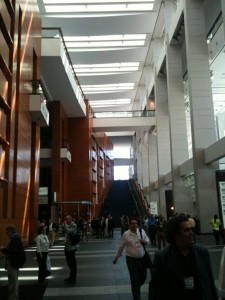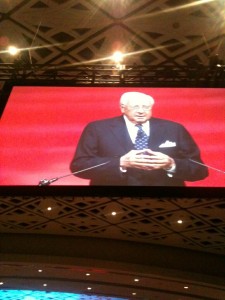Insights on Collaboration

The national American Institute of Architects Convention draws over 17,000 attendees from around the world. These practitioners, professionals and enthusiasts have converged upon Washington DC and are learning about and engaging in the large role that architecture and design play in, well, everything.
I had the pleasure of teaching a day-long workshop about the application of LEED and integrated design, the USGBC’s only workshop at the conference, and included attendees from as far away as India. Of particular note in this workshop is the need for project teams to openly set project goals prior to actual design. While a prerequisite for the forthcoming LEED 2012, this strategy of collaboration runs counter to the vast majority of projects and must be determined at the project outset.
Sustainability and energy efficiency are a significant theme in the conference presentations. Nearly a third of the seminars directly address sustainable design, a significant change from just a decade ago. The AIA Position Statements 42 and 45 directly recognize, engage and challenge the industry’s considerable ability to impact the built environment.
Of special interest were a series of seminars about the recently updated International Green Construction Code (IGCC). While too early to be yet adopted, this code will help to push the industry along towards greater sustainability targets. Intended as an alternative compliance path to the ASHRAE 189 standard, IGCC 2012 looks at interior environmental quality, commissioning, energy simulation and water efficiency. There is also a mention of measurement and verification of the ongoing building operations, linking design to actual building performance.

The noted historian David McCullough delivered the keynote address. The great man spoke of architecture’s link to history and the undeniable role that France has played in inspiring a nascent, young, developing, mature, and then dominant America. The ‘pursuit of happiness,’ a term directly inspired by French ideals at that time, was not the notion of ease and plenty that it has today become; it was seen as a culture in which people strive and excel, and a place with the ability to improve with each generation. “Nothing of consequence is ever achieved alone,” and we may be collaborators with the past and with ideals as much as we may collaborate with partners.
AIA 2012 Convention Workshop Information
BD+C 301: Implementing the Building Design + Construction LEED Rating System
May 16th, 8:30 am – 5:30 pm
Marc Mondor, AIA, LEED Faculty, Principal, evolveEA
Program Code: WE201
Location: Washington Convention Center, Room 144AB, Washington DC
Learning Units: 7.50 LU\HSW\SD
Description:
Learn how to apply the LEED BD+C rating systems by walking through the phases of a typical project and the key decisions that project teams must make, including key stakeholder considerations. Engage in interactive, case-based activities to work hands-on with LEED implementation strategies and rating system tools. The focus is on the LEED for New Construction & Major Renovations and LEED for Core & Shell. Required prior coursework: BD+C 251 or BD+C 252 or equivalent knowledge; Attendees should be familiar with these LEED rating systems.
Learning Objective:
1. Explain unique aspects of the LEED 2009 for New Construction & Major Renovations rating system
2. Apply and facilitate the LEED process with stakeholders
3. Apply LEED tools to a new construction or major renovation project
4. Identify key green decisions throughout the process of earning LEED certification

